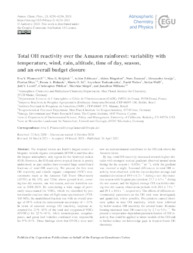Total OH reactivity over the Amazon rainforest: variability with temperature, wind, rain, altitude, time of day, season, and an overall budget closure.
Total OH reactivity over the Amazon rainforest: variability with temperature, wind, rain, altitude, time of day, season, and an overall budget closure.
Author(s): PFANNERSTILL, E. Y.; REIJRINK, N. G.; EDTBAUER, A.; RINGSDORF, A.; ZANNONI, N.; ARAUJO, A. C. de; DITAS, F.; HOLANDA, B. A.; SÁ, M. O.; TSOKANKUNKU, A.; WALTER, D.; WOLFF, S.; LAVRIC, J. V.; PÖHLKER, C.; SÖRGEL, M.; WILLIAMS, J.
Summary: The tropical forests are Earth's largest source of biogenic volatile organic compounds (BVOCs) and thus also the largest atmospheric sink region for the hydroxyl radical (OH). However, the OH sink above tropical forests is poorly understood, as past studies have revealed large unattributed fractions of total OH reactivity. We present the first total OH reactivity and volatile organic compound (VOC) measurements made at the Amazon Tall Tower Observatory (ATTO) at 80, 150, and 320 m above ground level, covering two dry seasons, one wet season, and one transition season in 2018-2019. By considering a wide range of previously unaccounted for VOCs, which we identified by proton transfer reaction time-of-flight mass spectrometry (PTR-ToF-MS), the unattributed fraction was with an overall average of 19 % within the measurement uncertainty of ~35 %. In terms of seasonal average OH reactivity, isoprene accounted for 23 %-43 % of the total and oxygenated VOCs (OVOCs) for 22 %-40 %, while monoterpenes, sesquiterpenes, and green leaf volatiles combined were responsible for 9 %-14 %. These findings show that OVOCs were until now an underestimated contributor to the OH sink above the Amazon forest. By day, total OH reactivity decreased towards higher altitudes with strongest vertical gradients observed around noon during the dry season (-0.026 s-1 m-1), while the gradient was inverted at night. Seasonal differences in total OH reactivity were observed, with the lowest daytime average and standard deviation of 19.9 ± 6.2 -1 during a wet-dry transition season with frequent precipitation; 23.7 ± 6.5 -1 during the wet season; and the highest average OH reactivities during two dry-season observation periods with 28.1 ± 7.9 -1 and 29.1 ± 10.8 -1, respectively. The effects of different environmental parameters on the OH sink were investigated, and quantified, where possible. Precipitation caused short-term spikes in total OH reactivity, which were followed by below-normal OH reactivity for several hours. Biomass burning increased total OH reactivity by 2.7 to 9.5 -1. We present a temperature-dependent parameterization of OH reactivity that could be applied in future models of the OH sink to further reduce our knowledge gaps in tropical-forest OH chemistry
Publication year: 2021
Types of publication: Journal article
Unit: Embrapa Eastern Amazon
Keywords: Amazonia, Compostos orgânicos voláteis, Floresta Tropical
Observation
Some of Embrapa's publications are published as ePub files. To read them, use or download one of the following free software options to your computer or mobile device. Android: Google Play Books; IOS: iBooks; Windows and Linux: Calibre.
Access other publications
Access the Agricultural Research Database (BDPA) to consult Embrapa's full library collection and records.
Visit Embrapa Bookstore to purchase books and other publications sold by Embrapa.

